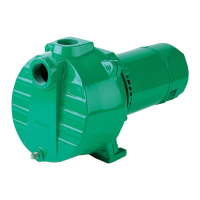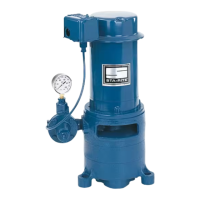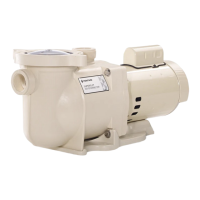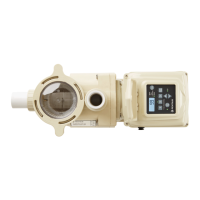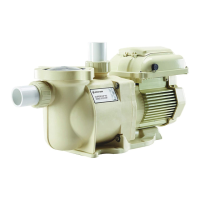26850A002 06/04/14
4
REMOVING AND REPLACING SEATS:
CENTER POST VALVES - D65-20 SERIES
Remove valve and cylinder caps which provide
access to both suction and discharge valves. Remove
the stainless steel shoulder screw which serves as a
valve guide and spring retainer. Remove shoulder screw,
spring retainer, spring and valve from the pump fluid end.
Assemble stud, retainer and three large screws by
inserting screw heads thru holes in valve seat. Rotate
retainer to the right until heads catch and secure in
place by screwing stud firmly. Place plate over stud,
screw on nut and torque slowly with wrench until seat
breaks loose.
Suction valve seats are removed as above, except two
stud lengths are joined using coupling.
TO REPLACE
Inspect tapered valve seat bore in fluid end for rust and
wipe out excess with a rag. Place a new lower seat
in tapered hole. Drive lower seat firmly into place and
repeat for upper seat being sure to also inspect the
tapered bore for rust.
Reassemble valve, spring and spring retainer. Confirm
that springs are in correct location. Be sure that shoulder
screw is bottomed in valve seat. This screw is furnished
with a Nylock locking pellet to prevent accidental
loosening of screw. Also be certain that valve disc is
installed on the valve with the flat face down. Inspect
O-rings on valve and cylinder caps. Replace if O-rings
show signs of wear.
NOTE FOR ALL D65 SERIES: Reassemble valve spring
in correct location. When upper and lower valve seats
are the same size, the heavier spring (larger diameter
wire) is always installed on upper or discharge valve.
REPLACING PISTON ROD SEALS
The rod seal assembly contains two seals and two oil
seals with lips facing power end. The oil seal can be
replaced without taking the fluid end off by removing the
cylinder and piston to allow access for oil seal housing.
Unscrew two Allen screws and place into the other two
tapped holes. Gradually screw them in to push oil seal
housing off the retainer. After assembling new seals in
oil seal housing, an assembly thimble should be used
on the end of the crosshead rod for sliding the oil seal
housing back into retainer. Check gasket and replace if
damaged.
An assembly thimble should be used on the small end of
the piston rod to expand sealing edge as it is pushed on.
The thimble should be machined from high carbon steel
and polished on the exterior to reduce possibility of seal
lip damage.
REMOVING CRANKSHAFT AND
PINION SHAFT
Remove packing assemblies and remove connecting link
caps. Move the link-crosshead assembly as far forward
as possible. On some models, it may be necessary to
remove the fluid cylinder body to obtain clearance for
crankshaft removal.
Secure separation of the crankshaft gear and gear case
so that crankshaft will be held in place against pinion
shaft. Remove both crankshaft bearing caps. Hold
crankshaft at ring gear and left-hand link journal to
prevent dropping into bearing bores. Remove from gear
case by moving crankshaft to the right until left end can
be swung free.
To remove pinion shaft, observe inside of gear case
to see if small sheet metal plates are in front of each
bearing. These plates must be removed prior to
bearing caps.
Tap the end of the pinion shaft extension to remove the
bearing cup at the opposite end. After removing pinion
shaft, the remaining bearing cup can be removed by
gently tapping against the peripheral edge of the cup
with a brass rod.
REPLACING PINION SHAFT AND
SHIMMING BEARINGS
After installing the link-crosshead assemblies and
moving them toward the fluid end as far as possible,
tap the right-hand pinion shaft bearing cup into position
using the bearing cap. Make sure that the spacer is
properly seated on drive end of pinion shaft. The curve
side should match the fillet radius of pinion shaft. Place
pinion shaft in position and tap left-hand bearing cup
into place.
Cover the shaft keyway to protect lip of oil seal. Slide on
the open bearing cap with a .030" shim. Tighten the four
cap screws to recommended torque.
Install other cap using total shim thickness. Tighten cap
screws holding pinion or crankshaft caps to gear case.
Rotate pinion shaft back and forth, applying about 15
lbs. axial force to properly seat tapered rollers. Measure
end-play by using an indicating gauge.
Subtract recommended end-play (.005" –.009") from
actual end-play. This is the amount of shim that must
be removed. After excess shim thickness has been
removed, replace caps and retighten cap screws.
Measure end-play, and if end-play is not within limits
recommended, add or subtract shims as required.
Pinion bearing shims are made of .002" layers bonded
together. Start separation of layers by heating edge, then
peel back.
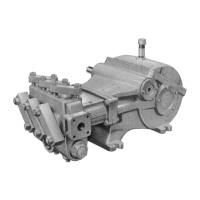
